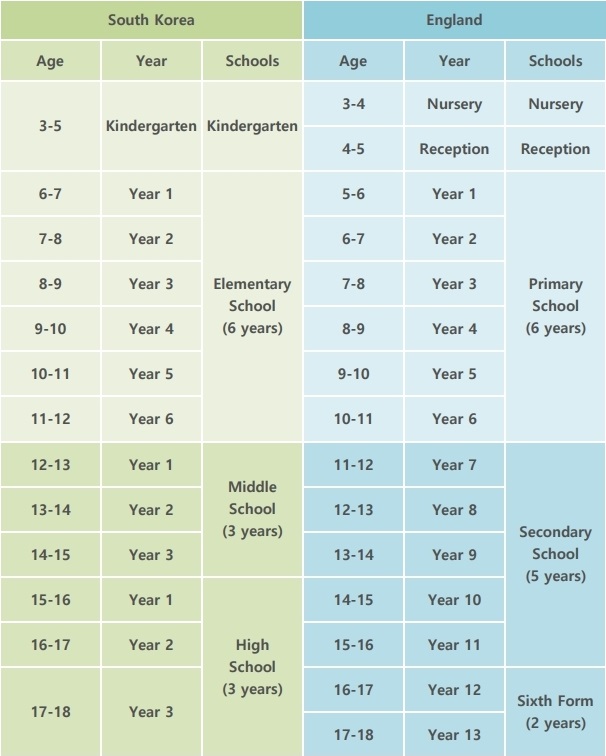Korea has traditionally placed great importance on education as a means for self-fulfillment as well as for social advancement. Today, Korea boasts one of the highest literacy rates in the world. It is a well- recognized fact that Korea’s well-educated people have been the primary source of the rapid economic growth that the nation has achieved during the past six decades. The Ministry of Education (MOE) is the government body responsible for the formulation and implementation of educational policies. The government provides guidance on basic policy matters as well as financial assistance. Korea has a single-track 6-3-3-4 system, which denotes six years of elementary school, three years of middle school, three years of high school, and four years of college or university which also offer graduate courses leading to master’s degrees and doctoral degrees. The single track has been a characteristic of the Korean education system, which maintains a single ladder system of schooling in order to ensure that every citizen can receive primary, secondary, and tertiary education.

Education in Korea 2020
Education in Korea (2020), published by the Ministry of Education(PDF)
The National Curriculum
The National Curriculum for the Primary and Secondary Schools 2022(PDF)
Pre-Primary Education
The national kindergarten curriculum has been reformed ten times since the first curriculum was established in 1969. The Nuri Curriculum was implemented for all five-year-olds in 2012, and was expanded to cover all three to four-year-olds in 2013. The Nuri Curriculum is designed to promote the development of children in five key areas (physical exercise, health, communication, social relationship, artistic experience, nature exploration) with the aim to promote balanced growth of both mind and body.
Primary Education
Primary education in Korea is free and compulsory providing the general rudimentary education necessary in life. Enrollment rate at primary schools is as high as 99.9%. The quantitative expansion of primary education is due to the high public zeal for education and the educational policies of the government. The sudden increase in the number of students and the migration of the rural population into cities has prompted the government to create an education tax in 1982 to finance the expansion and modernization of physical facilities and to improve the socio-economic status of teachers. As a result, the number of students per class dropped to 34.8 in 1990. Overcrowded schools have been divided into smaller ones and the double shift system of classes has been terminated. The government will continue to strive to improve primary education. With the revision of the regulation that prohibited children under six from entering primary school, even five year olds who are thought to have the ability became eligible to enter school if there is space. In addition, to expand foreign language education, English has been taught as a part of the regular curriculum starting in 1997, one hour per week for third and fourth graders, two hours per week for fifth and sixth grade students.
Secondary Education
High school course in Korea consists of three years. Individuals who graduate from middle schools or pass a qualification exam and/or an assessment that offers equivalent credits can be admitted into high schools. There are four types of high schools- General High Schools, Special-Purposed High Schools, Vocational High Schools, and Autonomous High Schools. Student selection procedures differ by school types and/or school location (e.g., metropolitan or provincial areas). Students are required to pay admission fees and tuition since high school is not considered compulsory education in Korea.
Higher Education
The purposes of universities and colleges are to develop students’ personality, teach and research the profound theories of science and arts necessary for the development of the nation and human society (Article 28 of the Higher Education Act). Higher education is provided to high school graduates or individuals with equivalent academic abilities approved by relevant laws in Korea, and a bachelor’s degree or a professional license is conferred to those who complete the curriculum. The years required for university graduation are two to four years for Junior Colleges and four years for universities, yet two years of preparatory courses and thus six years in total are required for the fields of medicine, traditional Asian medicine, dental, veterinary medicine, and pharmacology.
Special Education
Special education provides relative curricula and services (e.g., counseling service, family support, treatment support, assistant personnel support, supplementary technology support, supplementary academic support, etc.) in order to meet the needs of students with diverse types of disabilities and characteristics. Kindergarten, elementary school, middle school, and high school education are compulsory education for individuals with special needs, in which free education is provided to children under three-year-olds as well as those who wish to continue education in a specific major (i.e., individuals with special needs who has a high school diploma and wants to continue studying career and vocation education).